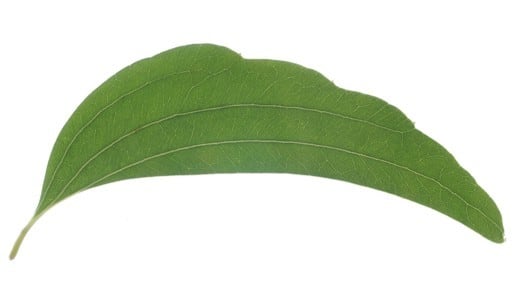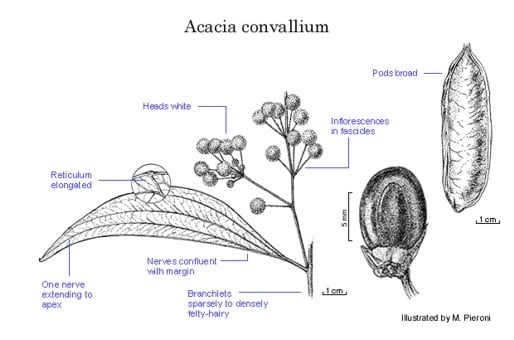Acacia convallium Pedley
WATTLE
Acacias of Australia
Family
Fabaceae
Distribution
Confined to the Coburg Peninsula and the upper parts of the catchments of the South and East Alligator and Liverpool Rivers, N.T.
Description
Tree to 6 m tall. Branchlets terete with felty covering of short hairs, glabrescent. Phyllodes ovate, falcate, 9–17.5 cm long, 1.2–4 cm wide, with short sparse weak spreading hairs, sometimes confined to base; longitudinal nerves 2 or 3 (–4), prominent, only one reaching apex, all running into lower margin at base, with oblique secondary nerves forming a reticulum; glands 2–4 (–5) on upper margin; pulvinus 5–10 mm long. Heads in fascicles of 4–6 heads, with up to 7 fascicles along indeterminate axes in upper axils, c. 30-flowered, creamy to golden yellow; peduncles 12–17 (–23) mm long, with spreading hairs. Flowers 5-merous; sepals free, c. 1 mm long, with spreading hairs in upper half; corolla c. 1.6 mm long, lobed to about middle, with spreading hairs on lobes; stamens c. 3.5 mm long; ovary glabrous. Pods to 11 cm long, 28–36 mm wide; valves woody, glabrous, reticulately nerved; marginal wing 2.5–3.5 mm wide. Seeds transverse, 8–8.5 mm long, 2.5–3.5 mm wide, 3–3.5 mm thick, arranged in depressions in the valves; areole large; aril stout, terminal, cupular.
Phenology
Flowers Apr.–May; fruits Sept.–Nov.
Habitat
Usually occurs on rather deep sandy soil in gorges or on skeletal soil on sandstone escarpments.
Specimens
N.T.: East Alligator R. area, C.R.Dunlop 3421 (BRI, DNA, K); 44 km SE of Oenpelli, C.R.Dunlop 4926 (BRI, DNA); 14 km NE of Mann River Gorge, G.Leach & C.R.Dunlop 1590 (BRI, DNA); along road to Smith Point, 73.5 km NW of Murgenella, M.McDonald 421 (BRI).
Notes
Acacia convallium is allied to A. sericata, but lacks the stellate hairs so prominent on the phyllodes, branchlets and peduncles of that species, and more closely to A. platycarpa, but the areoles among the anastomoses of the nerves of its phyllodes are larger and more elongate, its branchlets are usually pubescent not pruinose, and it has more flower heads in each fascicle of the inflorescence. It differs from both in having somewhat acute phyllodes not widest above the middle. The cohesion of the lower part of the stamens is most unusual in species of Acacia.
FOA Reference
Data derived from Flora of Australia Volumes 11A (2001), 11B (2001) and 12 (1998), products of ABRS, ©Commonwealth of Australia
Author
L.Pedley
This identification key and fact sheets are available as a mobile application:
URL: https://apps.lucidcentral.org/wattle/
© Copyright 2018. All rights reserved.









